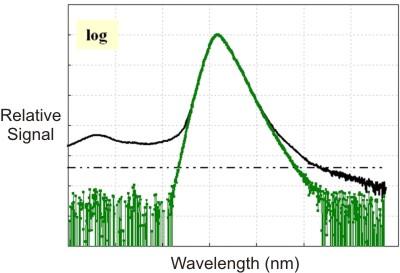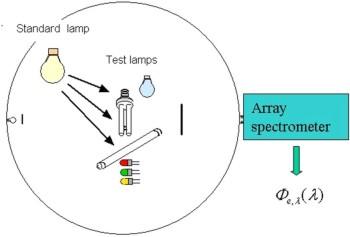Spectral measurement
Realization of total spectral radiant flux scale:
Conventional sphere-photometer systems are being replaced by sphere-spectroradiometer systems (shown to the right) to measure light sources for total (spatially-integrated) spectral radiant flux and for obtaining all the photometric, radiometric, and colorimetric quantities with a single measurement. These sphere-spectroradiometer systems need to be calibrated against total spectral flux standards.
We have realized the total spectral radiant flux (TSRF) scale (unit: W/nm) from 300 nm to 1100 nm by using a goniometer equipped with a fast CCD-array spectroradiometer. This realization is a combination of two approaches: measuring the relative TSRF of a tungsten quartz halogen (QTH) lamp using the goniometer and determining the absolute scale factor by calibrating the QTH lamp for total luminous flux in the NIST 2.5-m integrating sphere.
The measurement errors of the relative TSRF include CCD nonlinearity and spectral stray light in the spectroradiometer. Among these errors stray light is the dominant source of error in the blue and UV regions, and the application of the stray-light correction is critical for this realization to achieve small uncertainties.
For additional details, see NIST Gonio-spectroradiometer and Calibration and transfer standards for total spectral radiant flux.
Measurement of total luminous flux of LEDs
When a sphere-spectroradiometer system (shown at the top right) is used to measure total luminous flux (unit: lumen) of a deep-blue or even blue LED, a significant additional measurement error (for example, 5 %) may be introduced due to auto-fluorescence of the coating of the integrating sphere. The auto-fluorescence makes the measured total luminous flux value too high. The reason for the large measurement error is the value of the spectral luminous efficiency function, V(λ), is small in the deep-blue region and large in the green region.
The auto-fluorescence of the coating can be corrected by using the stray-light correction method (see Stray light correction). In this case, the sphere and the spectroradiometer together are characterized for a set of SLSFs that include the effect of coating's auto-fluorescence. Therefore, the derived stray-light correction matrix corrects auto-fluorescence of the sphere coating as well as the stray light of the spectroradiometer.
For more technical information, see Simple spectral stray light correction method for array spectroradiometers.
Measurement of total radiant flux of LEDs:
For the case of measuring a UV LED for total radiant flux (unit: W) using a sphere-spectroradiometer system as shown at the top right, the measurement error arising from stray light inside the spectroradiometer can be significant (e.g., 10 % for a 380-nm UV LED). The causes of this measurement error are due to the relatively low spectral radiant flux of a total spectral radiant flux standard lamp for the system calibration in UV region and the spectral differences between the spectra of a UV LED and the total spectral radiant flux standard lamp. Thus, application of stray-light correction is critical for the measurement of UV LEDs.
For more technical information, see Measurement of total radiant flux of UV LEDs.

Measurement of LED color
Array spectroradiometers are the most commonly used instruments for measurement of LED color quantities in testing laboratories and in manufacturing facilities. These measurements are subject to various sources of error such as bandpass, wavelength scale, detector nonlinearity, and spectral stray light in the spectroradiometer. The bandpass error is insignificant for a spectroradiometer with a bandpass of less than 3 nm (which is typical nowadays). It is also not difficult to perform an accurate wavelength calibration for an instrument with a relatively narrow bandpass. And, the detector nonlinearity is typically corrected by the instrument manufacturer. Therefore, the dominant source of measurement error is often the spectral stray light in the spectroradiometer.

Measurement errors from spectral stray light can be significant, and errors as large as 0.01 can be introduced in the measurement of CIE chromaticity coordinate x, y for green LEDs. Stray-light correction is necessary for an array spectroradiometry to achieve acceptable uncertainties in measurement of LED color quantities.
For more technical information, see Stray light correction, Spectral Colour Measurement, and A flexible bandpass correction method for spectrometers.
Related Links
Contacts
Project Leader
-
(301) 975-2332

